FIN 200 Business Finance: Financial Analysis and Project Appraisal
VerifiedAdded on 2023/06/15
|11
|2579
|155
Homework Assignment
AI Summary
This assignment provides detailed solutions to various finance problems, including loan amortization, refinancing decisions, capital budgeting, and investment project evaluation. It covers topics such as calculating monthly loan payments, determining the outstanding loan balance after a certain period, evaluating loan restructuring options based on net present value, and analyzing the profitability of investment projects using payback period, net present value, and internal rate of return. Additionally, it includes an analysis of systematic and unsystematic risks, calculations of required rates of return using the Capital Asset Pricing Model (CAPM), and interpretation of financial ratios to assess a company's liquidity, solvency, and profitability. The document is a valuable resource for students seeking to understand and apply core concepts in business finance, available with other solved assignments and past papers on Desklib.
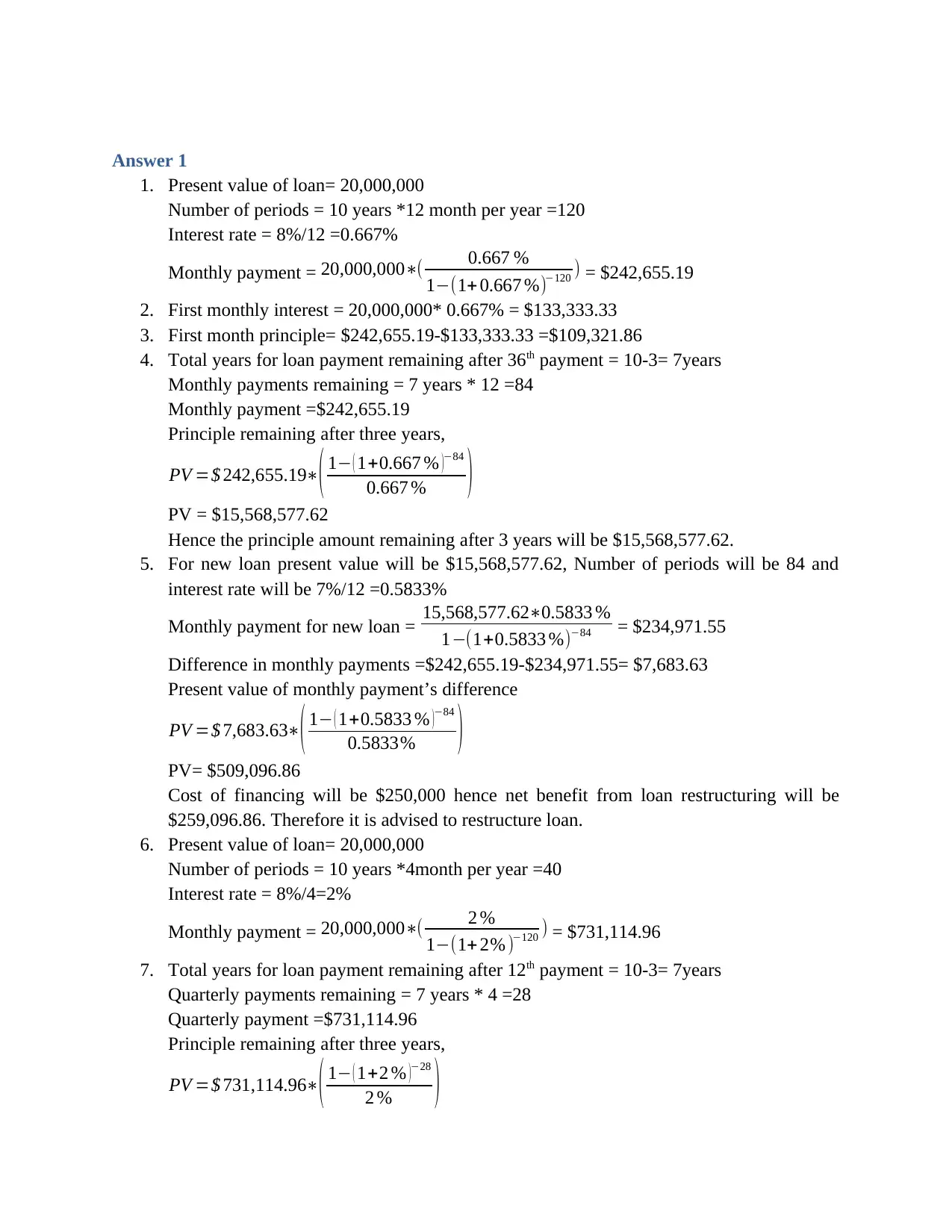
Answer 1
1. Present value of loan= 20,000,000
Number of periods = 10 years *12 month per year =120
Interest rate = 8%/12 =0.667%
Monthly payment = 20,000,000∗( 0.667 %
1−(1+ 0.667 %)−120 ) = $242,655.19
2. First monthly interest = 20,000,000* 0.667% = $133,333.33
3. First month principle= $242,655.19-$133,333.33 =$109,321.86
4. Total years for loan payment remaining after 36th payment = 10-3= 7years
Monthly payments remaining = 7 years * 12 =84
Monthly payment =$242,655.19
Principle remaining after three years,
PV =$ 242,655.19∗( 1− ( 1+0.667 % )−84
0.667 % )
PV = $15,568,577.62
Hence the principle amount remaining after 3 years will be $15,568,577.62.
5. For new loan present value will be $15,568,577.62, Number of periods will be 84 and
interest rate will be 7%/12 =0.5833%
Monthly payment for new loan = 15,568,577.62∗0.5833 %
1−(1+0.5833 %)−84 = $234,971.55
Difference in monthly payments =$242,655.19-$234,971.55= $7,683.63
Present value of monthly payment’s difference
PV =$ 7,683.63∗( 1− ( 1+0.5833 % )−84
0.5833% )
PV= $509,096.86
Cost of financing will be $250,000 hence net benefit from loan restructuring will be
$259,096.86. Therefore it is advised to restructure loan.
6. Present value of loan= 20,000,000
Number of periods = 10 years *4month per year =40
Interest rate = 8%/4=2%
Monthly payment = 20,000,000∗( 2 %
1−(1+ 2% )−120 ) = $731,114.96
7. Total years for loan payment remaining after 12th payment = 10-3= 7years
Quarterly payments remaining = 7 years * 4 =28
Quarterly payment =$731,114.96
Principle remaining after three years,
PV =$ 731,114.96∗( 1− ( 1+2 % )−28
2 % )
1. Present value of loan= 20,000,000
Number of periods = 10 years *12 month per year =120
Interest rate = 8%/12 =0.667%
Monthly payment = 20,000,000∗( 0.667 %
1−(1+ 0.667 %)−120 ) = $242,655.19
2. First monthly interest = 20,000,000* 0.667% = $133,333.33
3. First month principle= $242,655.19-$133,333.33 =$109,321.86
4. Total years for loan payment remaining after 36th payment = 10-3= 7years
Monthly payments remaining = 7 years * 12 =84
Monthly payment =$242,655.19
Principle remaining after three years,
PV =$ 242,655.19∗( 1− ( 1+0.667 % )−84
0.667 % )
PV = $15,568,577.62
Hence the principle amount remaining after 3 years will be $15,568,577.62.
5. For new loan present value will be $15,568,577.62, Number of periods will be 84 and
interest rate will be 7%/12 =0.5833%
Monthly payment for new loan = 15,568,577.62∗0.5833 %
1−(1+0.5833 %)−84 = $234,971.55
Difference in monthly payments =$242,655.19-$234,971.55= $7,683.63
Present value of monthly payment’s difference
PV =$ 7,683.63∗( 1− ( 1+0.5833 % )−84
0.5833% )
PV= $509,096.86
Cost of financing will be $250,000 hence net benefit from loan restructuring will be
$259,096.86. Therefore it is advised to restructure loan.
6. Present value of loan= 20,000,000
Number of periods = 10 years *4month per year =40
Interest rate = 8%/4=2%
Monthly payment = 20,000,000∗( 2 %
1−(1+ 2% )−120 ) = $731,114.96
7. Total years for loan payment remaining after 12th payment = 10-3= 7years
Quarterly payments remaining = 7 years * 4 =28
Quarterly payment =$731,114.96
Principle remaining after three years,
PV =$ 731,114.96∗( 1− ( 1+2 % )−28
2 % )
Paraphrase This Document
Need a fresh take? Get an instant paraphrase of this document with our AI Paraphraser

PV = $15,559,056
8. 8%
9. 8%
Answer 2
1. Future value of bond is 100 and present value of bond is 78.12, number of periods will be
10.
PV = FV
(1+r )n
78.12= 100
(1+r)10
r =2.5
2. Interest rate of bond is 3.5% and future value of bond is 100, number of periods will be 9.
PV = FV
(1+r )n
PV = 100
(1+0.035)9
PV =73.37
Return from bond = 73.37-78.12 = loss of $4.75
3. Coupon amount from the bond will be 2.5% of $1000 i.e. $25, number of periods will be
9, Interest rate of bond is 3.5% and future value of bond is 1000.
PV = C∗1−(1+ r)−n
r +F∗(1+r )−n
PV = 25∗1−(1+3.5 %)−9
3.5 % +F∗(1+3.5 %)−9
PV =923.92
Hence loss percentage = (1000-923.92)/923.92 = 8.23%
Loss percentage in part 2 =4.75/73.37 = 6.08%
Answer 3
Price of MacDonald’s share now
Next dividend = $3.7
Growth rate= 5%
Market rate of return =11%
8. 8%
9. 8%
Answer 2
1. Future value of bond is 100 and present value of bond is 78.12, number of periods will be
10.
PV = FV
(1+r )n
78.12= 100
(1+r)10
r =2.5
2. Interest rate of bond is 3.5% and future value of bond is 100, number of periods will be 9.
PV = FV
(1+r )n
PV = 100
(1+0.035)9
PV =73.37
Return from bond = 73.37-78.12 = loss of $4.75
3. Coupon amount from the bond will be 2.5% of $1000 i.e. $25, number of periods will be
9, Interest rate of bond is 3.5% and future value of bond is 1000.
PV = C∗1−(1+ r)−n
r +F∗(1+r )−n
PV = 25∗1−(1+3.5 %)−9
3.5 % +F∗(1+3.5 %)−9
PV =923.92
Hence loss percentage = (1000-923.92)/923.92 = 8.23%
Loss percentage in part 2 =4.75/73.37 = 6.08%
Answer 3
Price of MacDonald’s share now
Next dividend = $3.7
Growth rate= 5%
Market rate of return =11%
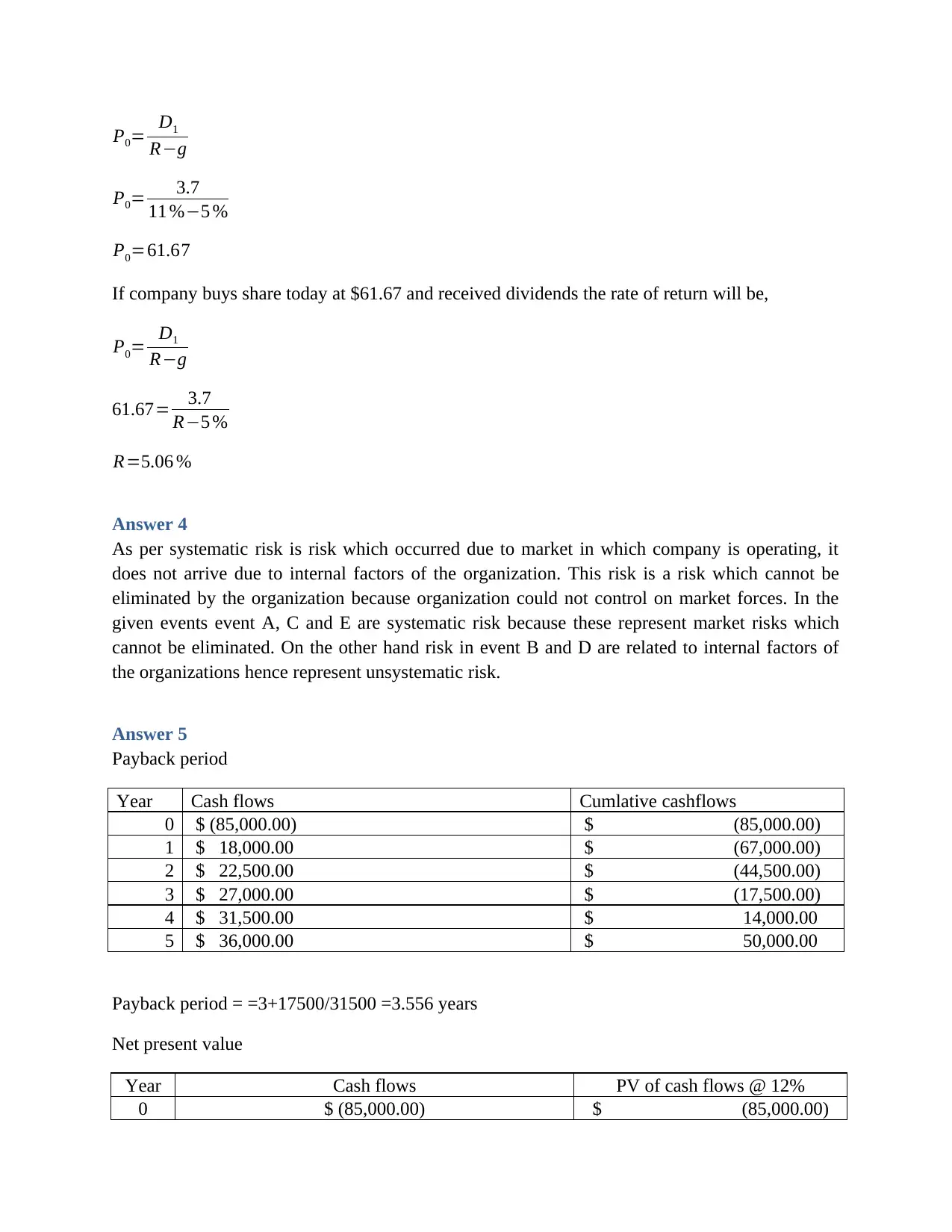
P0= D1
R−g
P0= 3.7
11 %−5 %
P0=61.67
If company buys share today at $61.67 and received dividends the rate of return will be,
P0= D1
R−g
61.67= 3.7
R−5 %
R=5.06 %
Answer 4
As per systematic risk is risk which occurred due to market in which company is operating, it
does not arrive due to internal factors of the organization. This risk is a risk which cannot be
eliminated by the organization because organization could not control on market forces. In the
given events event A, C and E are systematic risk because these represent market risks which
cannot be eliminated. On the other hand risk in event B and D are related to internal factors of
the organizations hence represent unsystematic risk.
Answer 5
Payback period
Year Cash flows Cumlative cashflows
0 $ (85,000.00) $ (85,000.00)
1 $ 18,000.00 $ (67,000.00)
2 $ 22,500.00 $ (44,500.00)
3 $ 27,000.00 $ (17,500.00)
4 $ 31,500.00 $ 14,000.00
5 $ 36,000.00 $ 50,000.00
Payback period = =3+17500/31500 =3.556 years
Net present value
Year Cash flows PV of cash flows @ 12%
0 $ (85,000.00) $ (85,000.00)
R−g
P0= 3.7
11 %−5 %
P0=61.67
If company buys share today at $61.67 and received dividends the rate of return will be,
P0= D1
R−g
61.67= 3.7
R−5 %
R=5.06 %
Answer 4
As per systematic risk is risk which occurred due to market in which company is operating, it
does not arrive due to internal factors of the organization. This risk is a risk which cannot be
eliminated by the organization because organization could not control on market forces. In the
given events event A, C and E are systematic risk because these represent market risks which
cannot be eliminated. On the other hand risk in event B and D are related to internal factors of
the organizations hence represent unsystematic risk.
Answer 5
Payback period
Year Cash flows Cumlative cashflows
0 $ (85,000.00) $ (85,000.00)
1 $ 18,000.00 $ (67,000.00)
2 $ 22,500.00 $ (44,500.00)
3 $ 27,000.00 $ (17,500.00)
4 $ 31,500.00 $ 14,000.00
5 $ 36,000.00 $ 50,000.00
Payback period = =3+17500/31500 =3.556 years
Net present value
Year Cash flows PV of cash flows @ 12%
0 $ (85,000.00) $ (85,000.00)
⊘ This is a preview!⊘
Do you want full access?
Subscribe today to unlock all pages.

Trusted by 1+ million students worldwide

1 $ 18,000.00 $ 16,071.43
2 $ 22,500.00 $ 17,936.86
3 $ 27,000.00 $ 19,218.07
4 $ 31,500.00 $ 20,018.82
5 $ 36,000.00 $ 20,427.37
Net present value $ 8,672.54
Internal rate of return
Year Cash flows PV of cash flows @15.584%
0 $ (85,000.00) $ (85,000.00)
1 $ 18,000.00 $ 15,573.09
2 $ 22,500.00 $ 16,841.74
3 $ 27,000.00 $ 17,485.20
4 $ 31,500.00 $ 17,648.98
5 $ 36,000.00 $ 17,450.74
Net present value $ (0)
At interest rate 15.584% net present value is zero, it concludes that project have a internal rate of
return at 15.584%.
Recommendations
As company is having positive net present value and internal rate of return more than required
rate of return it is recommended to company to continue with the project. Every company make
evaluation of investment projects because these projects require huge capital implementation and
if project would not provide satisfactory income then company will face loss.
Answer 6
1. And 2.
Year Renovate Replace
PV of Renovate
cash flows
PV of Replace
cash flows
0 -$9,000,000.00 -$1,000,000.00 -$9,000,000.00 -$1,000,000.00
1 $ 3,500,000.00 $ 600,000.00 $ 3,043,478.26 $ 521,739.13
2 $ 3,000,000.00 $ 500,000.00 $ 2,268,431.00 $ 378,071.83
3 $ 3,000,000.00 $ 400,000.00 $ 1,972,548.70 $ 263,006.49
4 $ 2,800,000.00 $ 300,000.00 $ 1,600,909.09 $ 171,525.97
5 $ 2,500,000.00 $ 200,000.00 $ 1,242,941.84 $ 99,435.35
Net present value $ 1,128,308.89 $ 433,778.78
Rank 1 2
2 $ 22,500.00 $ 17,936.86
3 $ 27,000.00 $ 19,218.07
4 $ 31,500.00 $ 20,018.82
5 $ 36,000.00 $ 20,427.37
Net present value $ 8,672.54
Internal rate of return
Year Cash flows PV of cash flows @15.584%
0 $ (85,000.00) $ (85,000.00)
1 $ 18,000.00 $ 15,573.09
2 $ 22,500.00 $ 16,841.74
3 $ 27,000.00 $ 17,485.20
4 $ 31,500.00 $ 17,648.98
5 $ 36,000.00 $ 17,450.74
Net present value $ (0)
At interest rate 15.584% net present value is zero, it concludes that project have a internal rate of
return at 15.584%.
Recommendations
As company is having positive net present value and internal rate of return more than required
rate of return it is recommended to company to continue with the project. Every company make
evaluation of investment projects because these projects require huge capital implementation and
if project would not provide satisfactory income then company will face loss.
Answer 6
1. And 2.
Year Renovate Replace
PV of Renovate
cash flows
PV of Replace
cash flows
0 -$9,000,000.00 -$1,000,000.00 -$9,000,000.00 -$1,000,000.00
1 $ 3,500,000.00 $ 600,000.00 $ 3,043,478.26 $ 521,739.13
2 $ 3,000,000.00 $ 500,000.00 $ 2,268,431.00 $ 378,071.83
3 $ 3,000,000.00 $ 400,000.00 $ 1,972,548.70 $ 263,006.49
4 $ 2,800,000.00 $ 300,000.00 $ 1,600,909.09 $ 171,525.97
5 $ 2,500,000.00 $ 200,000.00 $ 1,242,941.84 $ 99,435.35
Net present value $ 1,128,308.89 $ 433,778.78
Rank 1 2
Paraphrase This Document
Need a fresh take? Get an instant paraphrase of this document with our AI Paraphraser
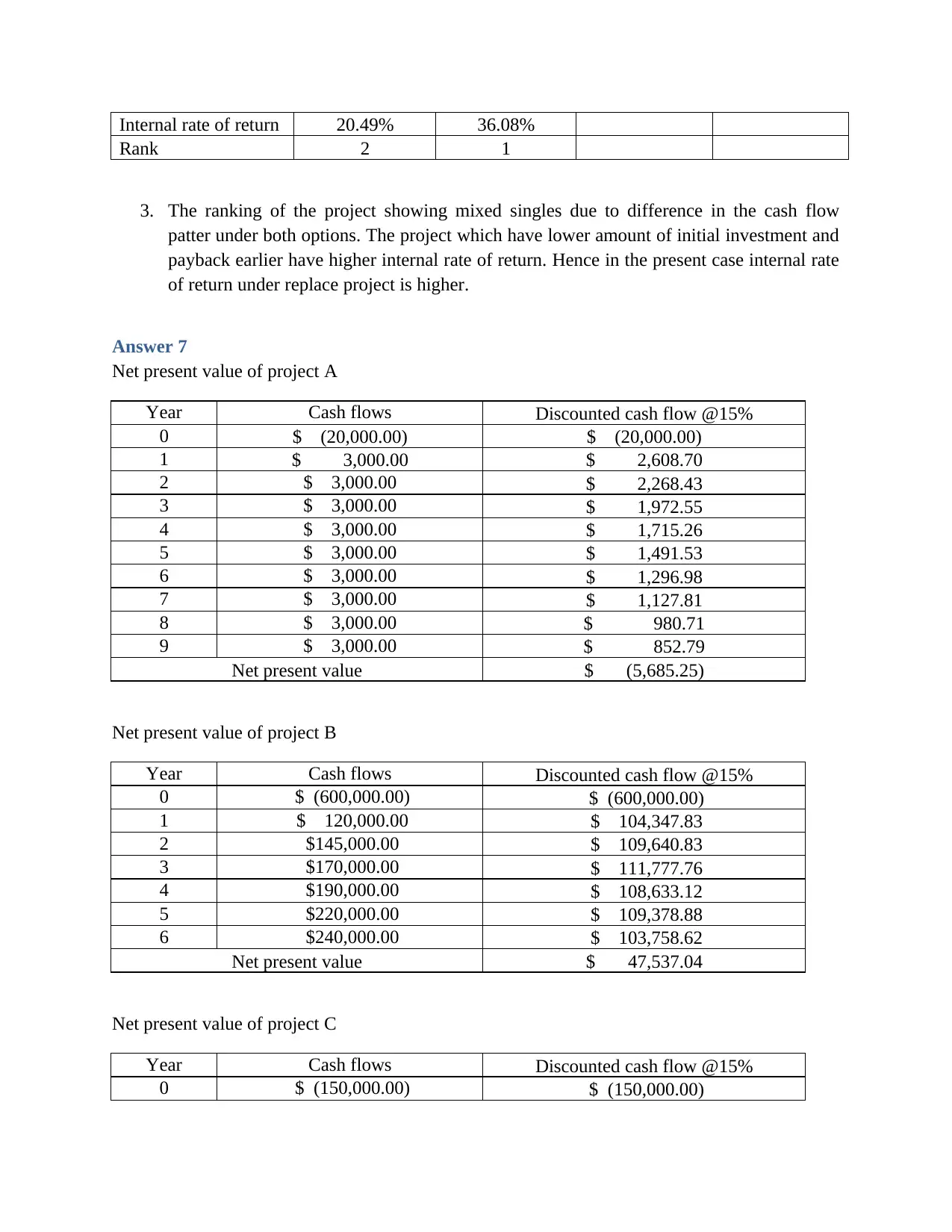
Internal rate of return 20.49% 36.08%
Rank 2 1
3. The ranking of the project showing mixed singles due to difference in the cash flow
patter under both options. The project which have lower amount of initial investment and
payback earlier have higher internal rate of return. Hence in the present case internal rate
of return under replace project is higher.
Answer 7
Net present value of project A
Year Cash flows Discounted cash flow @15%
0 $ (20,000.00) $ (20,000.00)
1 $ 3,000.00 $ 2,608.70
2 $ 3,000.00 $ 2,268.43
3 $ 3,000.00 $ 1,972.55
4 $ 3,000.00 $ 1,715.26
5 $ 3,000.00 $ 1,491.53
6 $ 3,000.00 $ 1,296.98
7 $ 3,000.00 $ 1,127.81
8 $ 3,000.00 $ 980.71
9 $ 3,000.00 $ 852.79
Net present value $ (5,685.25)
Net present value of project B
Year Cash flows Discounted cash flow @15%
0 $ (600,000.00) $ (600,000.00)
1 $ 120,000.00 $ 104,347.83
2 $145,000.00 $ 109,640.83
3 $170,000.00 $ 111,777.76
4 $190,000.00 $ 108,633.12
5 $220,000.00 $ 109,378.88
6 $240,000.00 $ 103,758.62
Net present value $ 47,537.04
Net present value of project C
Year Cash flows Discounted cash flow @15%
0 $ (150,000.00) $ (150,000.00)
Rank 2 1
3. The ranking of the project showing mixed singles due to difference in the cash flow
patter under both options. The project which have lower amount of initial investment and
payback earlier have higher internal rate of return. Hence in the present case internal rate
of return under replace project is higher.
Answer 7
Net present value of project A
Year Cash flows Discounted cash flow @15%
0 $ (20,000.00) $ (20,000.00)
1 $ 3,000.00 $ 2,608.70
2 $ 3,000.00 $ 2,268.43
3 $ 3,000.00 $ 1,972.55
4 $ 3,000.00 $ 1,715.26
5 $ 3,000.00 $ 1,491.53
6 $ 3,000.00 $ 1,296.98
7 $ 3,000.00 $ 1,127.81
8 $ 3,000.00 $ 980.71
9 $ 3,000.00 $ 852.79
Net present value $ (5,685.25)
Net present value of project B
Year Cash flows Discounted cash flow @15%
0 $ (600,000.00) $ (600,000.00)
1 $ 120,000.00 $ 104,347.83
2 $145,000.00 $ 109,640.83
3 $170,000.00 $ 111,777.76
4 $190,000.00 $ 108,633.12
5 $220,000.00 $ 109,378.88
6 $240,000.00 $ 103,758.62
Net present value $ 47,537.04
Net present value of project C
Year Cash flows Discounted cash flow @15%
0 $ (150,000.00) $ (150,000.00)
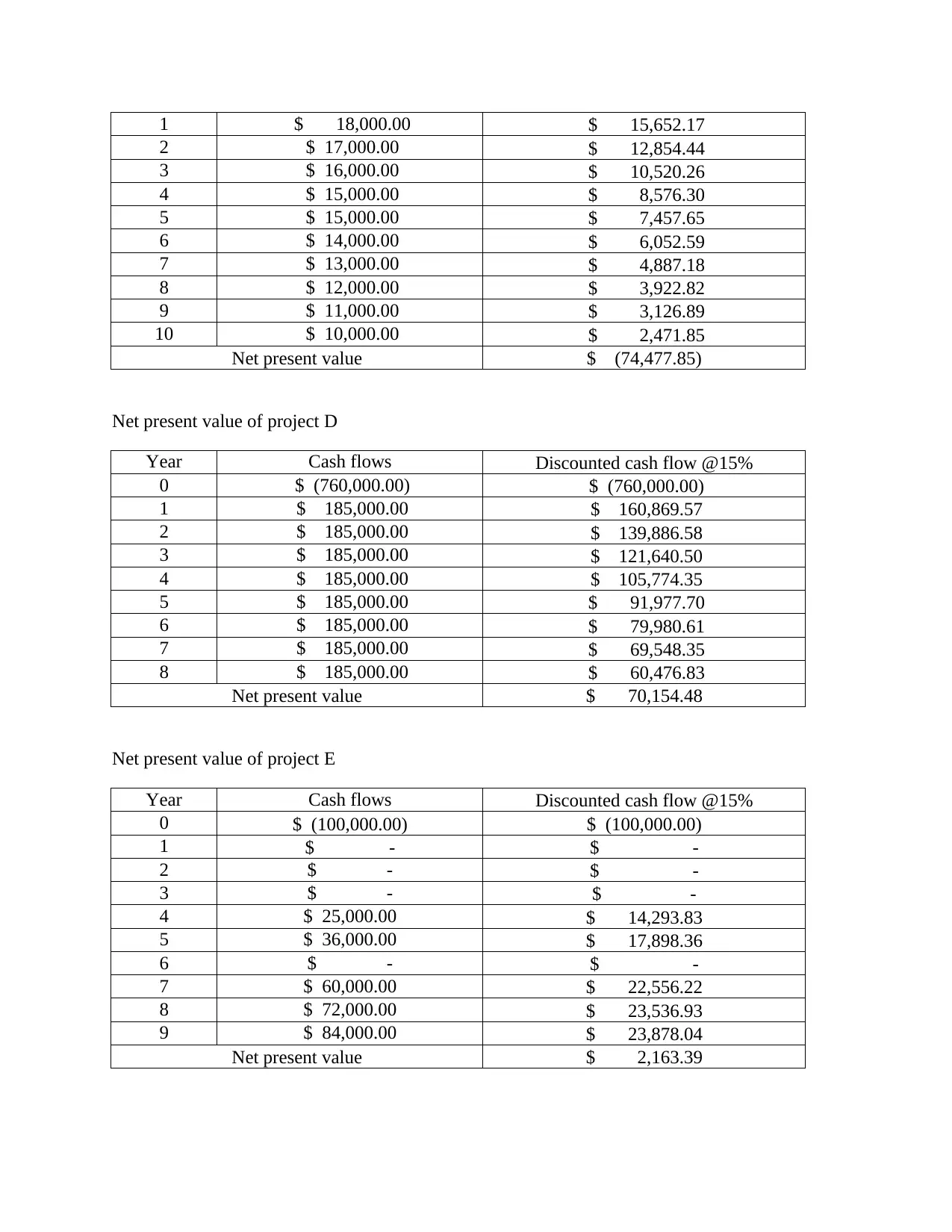
1 $ 18,000.00 $ 15,652.17
2 $ 17,000.00 $ 12,854.44
3 $ 16,000.00 $ 10,520.26
4 $ 15,000.00 $ 8,576.30
5 $ 15,000.00 $ 7,457.65
6 $ 14,000.00 $ 6,052.59
7 $ 13,000.00 $ 4,887.18
8 $ 12,000.00 $ 3,922.82
9 $ 11,000.00 $ 3,126.89
10 $ 10,000.00 $ 2,471.85
Net present value $ (74,477.85)
Net present value of project D
Year Cash flows Discounted cash flow @15%
0 $ (760,000.00) $ (760,000.00)
1 $ 185,000.00 $ 160,869.57
2 $ 185,000.00 $ 139,886.58
3 $ 185,000.00 $ 121,640.50
4 $ 185,000.00 $ 105,774.35
5 $ 185,000.00 $ 91,977.70
6 $ 185,000.00 $ 79,980.61
7 $ 185,000.00 $ 69,548.35
8 $ 185,000.00 $ 60,476.83
Net present value $ 70,154.48
Net present value of project E
Year Cash flows Discounted cash flow @15%
0 $ (100,000.00) $ (100,000.00)
1 $ - $ -
2 $ - $ -
3 $ - $ -
4 $ 25,000.00 $ 14,293.83
5 $ 36,000.00 $ 17,898.36
6 $ - $ -
7 $ 60,000.00 $ 22,556.22
8 $ 72,000.00 $ 23,536.93
9 $ 84,000.00 $ 23,878.04
Net present value $ 2,163.39
2 $ 17,000.00 $ 12,854.44
3 $ 16,000.00 $ 10,520.26
4 $ 15,000.00 $ 8,576.30
5 $ 15,000.00 $ 7,457.65
6 $ 14,000.00 $ 6,052.59
7 $ 13,000.00 $ 4,887.18
8 $ 12,000.00 $ 3,922.82
9 $ 11,000.00 $ 3,126.89
10 $ 10,000.00 $ 2,471.85
Net present value $ (74,477.85)
Net present value of project D
Year Cash flows Discounted cash flow @15%
0 $ (760,000.00) $ (760,000.00)
1 $ 185,000.00 $ 160,869.57
2 $ 185,000.00 $ 139,886.58
3 $ 185,000.00 $ 121,640.50
4 $ 185,000.00 $ 105,774.35
5 $ 185,000.00 $ 91,977.70
6 $ 185,000.00 $ 79,980.61
7 $ 185,000.00 $ 69,548.35
8 $ 185,000.00 $ 60,476.83
Net present value $ 70,154.48
Net present value of project E
Year Cash flows Discounted cash flow @15%
0 $ (100,000.00) $ (100,000.00)
1 $ - $ -
2 $ - $ -
3 $ - $ -
4 $ 25,000.00 $ 14,293.83
5 $ 36,000.00 $ 17,898.36
6 $ - $ -
7 $ 60,000.00 $ 22,556.22
8 $ 72,000.00 $ 23,536.93
9 $ 84,000.00 $ 23,878.04
Net present value $ 2,163.39
⊘ This is a preview!⊘
Do you want full access?
Subscribe today to unlock all pages.

Trusted by 1+ million students worldwide
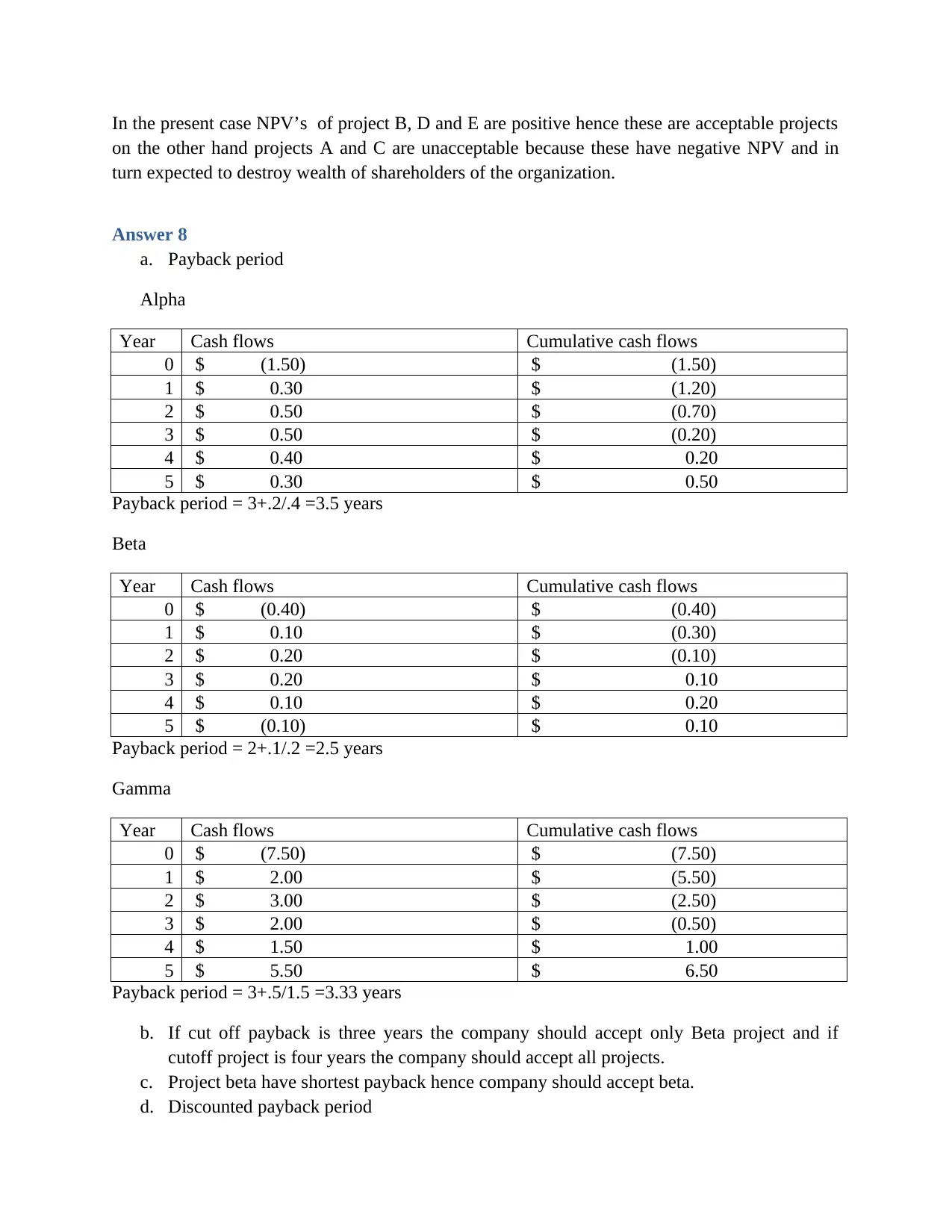
In the present case NPV’s of project B, D and E are positive hence these are acceptable projects
on the other hand projects A and C are unacceptable because these have negative NPV and in
turn expected to destroy wealth of shareholders of the organization.
Answer 8
a. Payback period
Alpha
Year Cash flows Cumulative cash flows
0 $ (1.50) $ (1.50)
1 $ 0.30 $ (1.20)
2 $ 0.50 $ (0.70)
3 $ 0.50 $ (0.20)
4 $ 0.40 $ 0.20
5 $ 0.30 $ 0.50
Payback period = 3+.2/.4 =3.5 years
Beta
Year Cash flows Cumulative cash flows
0 $ (0.40) $ (0.40)
1 $ 0.10 $ (0.30)
2 $ 0.20 $ (0.10)
3 $ 0.20 $ 0.10
4 $ 0.10 $ 0.20
5 $ (0.10) $ 0.10
Payback period = 2+.1/.2 =2.5 years
Gamma
Year Cash flows Cumulative cash flows
0 $ (7.50) $ (7.50)
1 $ 2.00 $ (5.50)
2 $ 3.00 $ (2.50)
3 $ 2.00 $ (0.50)
4 $ 1.50 $ 1.00
5 $ 5.50 $ 6.50
Payback period = 3+.5/1.5 =3.33 years
b. If cut off payback is three years the company should accept only Beta project and if
cutoff project is four years the company should accept all projects.
c. Project beta have shortest payback hence company should accept beta.
d. Discounted payback period
on the other hand projects A and C are unacceptable because these have negative NPV and in
turn expected to destroy wealth of shareholders of the organization.
Answer 8
a. Payback period
Alpha
Year Cash flows Cumulative cash flows
0 $ (1.50) $ (1.50)
1 $ 0.30 $ (1.20)
2 $ 0.50 $ (0.70)
3 $ 0.50 $ (0.20)
4 $ 0.40 $ 0.20
5 $ 0.30 $ 0.50
Payback period = 3+.2/.4 =3.5 years
Beta
Year Cash flows Cumulative cash flows
0 $ (0.40) $ (0.40)
1 $ 0.10 $ (0.30)
2 $ 0.20 $ (0.10)
3 $ 0.20 $ 0.10
4 $ 0.10 $ 0.20
5 $ (0.10) $ 0.10
Payback period = 2+.1/.2 =2.5 years
Gamma
Year Cash flows Cumulative cash flows
0 $ (7.50) $ (7.50)
1 $ 2.00 $ (5.50)
2 $ 3.00 $ (2.50)
3 $ 2.00 $ (0.50)
4 $ 1.50 $ 1.00
5 $ 5.50 $ 6.50
Payback period = 3+.5/1.5 =3.33 years
b. If cut off payback is three years the company should accept only Beta project and if
cutoff project is four years the company should accept all projects.
c. Project beta have shortest payback hence company should accept beta.
d. Discounted payback period
Paraphrase This Document
Need a fresh take? Get an instant paraphrase of this document with our AI Paraphraser
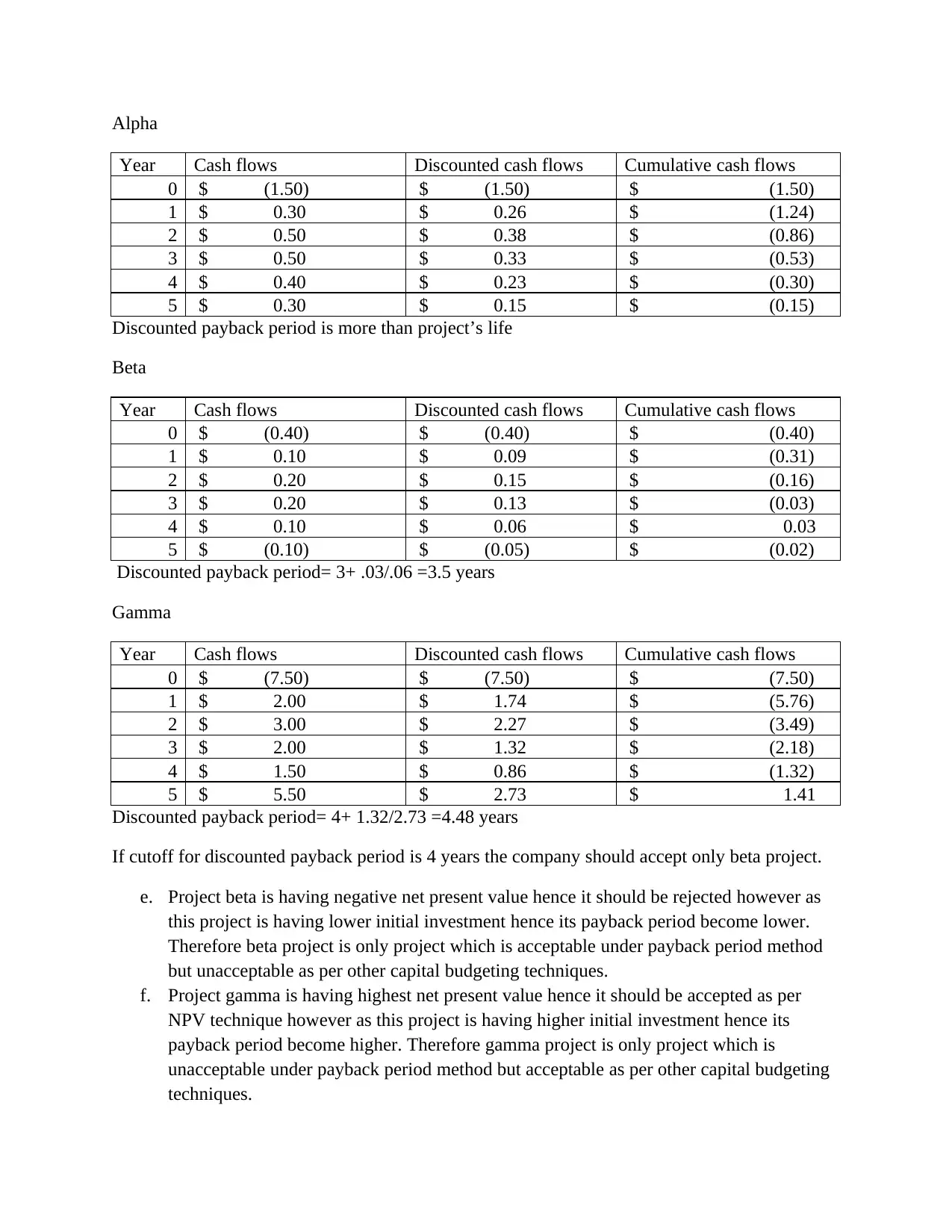
Alpha
Year Cash flows Discounted cash flows Cumulative cash flows
0 $ (1.50) $ (1.50) $ (1.50)
1 $ 0.30 $ 0.26 $ (1.24)
2 $ 0.50 $ 0.38 $ (0.86)
3 $ 0.50 $ 0.33 $ (0.53)
4 $ 0.40 $ 0.23 $ (0.30)
5 $ 0.30 $ 0.15 $ (0.15)
Discounted payback period is more than project’s life
Beta
Year Cash flows Discounted cash flows Cumulative cash flows
0 $ (0.40) $ (0.40) $ (0.40)
1 $ 0.10 $ 0.09 $ (0.31)
2 $ 0.20 $ 0.15 $ (0.16)
3 $ 0.20 $ 0.13 $ (0.03)
4 $ 0.10 $ 0.06 $ 0.03
5 $ (0.10) $ (0.05) $ (0.02)
Discounted payback period= 3+ .03/.06 =3.5 years
Gamma
Year Cash flows Discounted cash flows Cumulative cash flows
0 $ (7.50) $ (7.50) $ (7.50)
1 $ 2.00 $ 1.74 $ (5.76)
2 $ 3.00 $ 2.27 $ (3.49)
3 $ 2.00 $ 1.32 $ (2.18)
4 $ 1.50 $ 0.86 $ (1.32)
5 $ 5.50 $ 2.73 $ 1.41
Discounted payback period= 4+ 1.32/2.73 =4.48 years
If cutoff for discounted payback period is 4 years the company should accept only beta project.
e. Project beta is having negative net present value hence it should be rejected however as
this project is having lower initial investment hence its payback period become lower.
Therefore beta project is only project which is acceptable under payback period method
but unacceptable as per other capital budgeting techniques.
f. Project gamma is having highest net present value hence it should be accepted as per
NPV technique however as this project is having higher initial investment hence its
payback period become higher. Therefore gamma project is only project which is
unacceptable under payback period method but acceptable as per other capital budgeting
techniques.
Year Cash flows Discounted cash flows Cumulative cash flows
0 $ (1.50) $ (1.50) $ (1.50)
1 $ 0.30 $ 0.26 $ (1.24)
2 $ 0.50 $ 0.38 $ (0.86)
3 $ 0.50 $ 0.33 $ (0.53)
4 $ 0.40 $ 0.23 $ (0.30)
5 $ 0.30 $ 0.15 $ (0.15)
Discounted payback period is more than project’s life
Beta
Year Cash flows Discounted cash flows Cumulative cash flows
0 $ (0.40) $ (0.40) $ (0.40)
1 $ 0.10 $ 0.09 $ (0.31)
2 $ 0.20 $ 0.15 $ (0.16)
3 $ 0.20 $ 0.13 $ (0.03)
4 $ 0.10 $ 0.06 $ 0.03
5 $ (0.10) $ (0.05) $ (0.02)
Discounted payback period= 3+ .03/.06 =3.5 years
Gamma
Year Cash flows Discounted cash flows Cumulative cash flows
0 $ (7.50) $ (7.50) $ (7.50)
1 $ 2.00 $ 1.74 $ (5.76)
2 $ 3.00 $ 2.27 $ (3.49)
3 $ 2.00 $ 1.32 $ (2.18)
4 $ 1.50 $ 0.86 $ (1.32)
5 $ 5.50 $ 2.73 $ 1.41
Discounted payback period= 4+ 1.32/2.73 =4.48 years
If cutoff for discounted payback period is 4 years the company should accept only beta project.
e. Project beta is having negative net present value hence it should be rejected however as
this project is having lower initial investment hence its payback period become lower.
Therefore beta project is only project which is acceptable under payback period method
but unacceptable as per other capital budgeting techniques.
f. Project gamma is having highest net present value hence it should be accepted as per
NPV technique however as this project is having higher initial investment hence its
payback period become higher. Therefore gamma project is only project which is
unacceptable under payback period method but acceptable as per other capital budgeting
techniques.
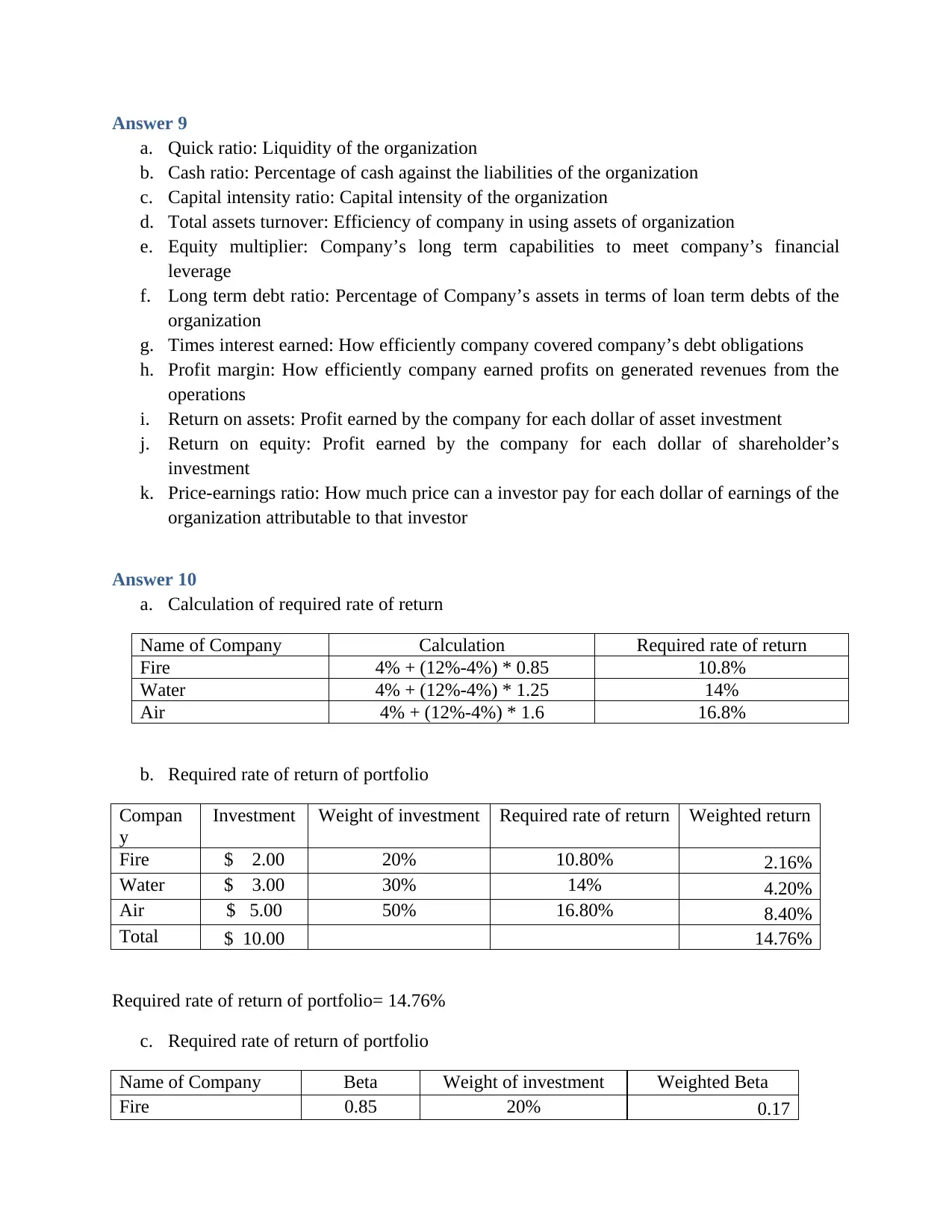
Answer 9
a. Quick ratio: Liquidity of the organization
b. Cash ratio: Percentage of cash against the liabilities of the organization
c. Capital intensity ratio: Capital intensity of the organization
d. Total assets turnover: Efficiency of company in using assets of organization
e. Equity multiplier: Company’s long term capabilities to meet company’s financial
leverage
f. Long term debt ratio: Percentage of Company’s assets in terms of loan term debts of the
organization
g. Times interest earned: How efficiently company covered company’s debt obligations
h. Profit margin: How efficiently company earned profits on generated revenues from the
operations
i. Return on assets: Profit earned by the company for each dollar of asset investment
j. Return on equity: Profit earned by the company for each dollar of shareholder’s
investment
k. Price-earnings ratio: How much price can a investor pay for each dollar of earnings of the
organization attributable to that investor
Answer 10
a. Calculation of required rate of return
Name of Company Calculation Required rate of return
Fire 4% + (12%-4%) * 0.85 10.8%
Water 4% + (12%-4%) * 1.25 14%
Air 4% + (12%-4%) * 1.6 16.8%
b. Required rate of return of portfolio
Compan
y
Investment Weight of investment Required rate of return Weighted return
Fire $ 2.00 20% 10.80% 2.16%
Water $ 3.00 30% 14% 4.20%
Air $ 5.00 50% 16.80% 8.40%
Total $ 10.00 14.76%
Required rate of return of portfolio= 14.76%
c. Required rate of return of portfolio
Name of Company Beta Weight of investment Weighted Beta
Fire 0.85 20% 0.17
a. Quick ratio: Liquidity of the organization
b. Cash ratio: Percentage of cash against the liabilities of the organization
c. Capital intensity ratio: Capital intensity of the organization
d. Total assets turnover: Efficiency of company in using assets of organization
e. Equity multiplier: Company’s long term capabilities to meet company’s financial
leverage
f. Long term debt ratio: Percentage of Company’s assets in terms of loan term debts of the
organization
g. Times interest earned: How efficiently company covered company’s debt obligations
h. Profit margin: How efficiently company earned profits on generated revenues from the
operations
i. Return on assets: Profit earned by the company for each dollar of asset investment
j. Return on equity: Profit earned by the company for each dollar of shareholder’s
investment
k. Price-earnings ratio: How much price can a investor pay for each dollar of earnings of the
organization attributable to that investor
Answer 10
a. Calculation of required rate of return
Name of Company Calculation Required rate of return
Fire 4% + (12%-4%) * 0.85 10.8%
Water 4% + (12%-4%) * 1.25 14%
Air 4% + (12%-4%) * 1.6 16.8%
b. Required rate of return of portfolio
Compan
y
Investment Weight of investment Required rate of return Weighted return
Fire $ 2.00 20% 10.80% 2.16%
Water $ 3.00 30% 14% 4.20%
Air $ 5.00 50% 16.80% 8.40%
Total $ 10.00 14.76%
Required rate of return of portfolio= 14.76%
c. Required rate of return of portfolio
Name of Company Beta Weight of investment Weighted Beta
Fire 0.85 20% 0.17
⊘ This is a preview!⊘
Do you want full access?
Subscribe today to unlock all pages.

Trusted by 1+ million students worldwide
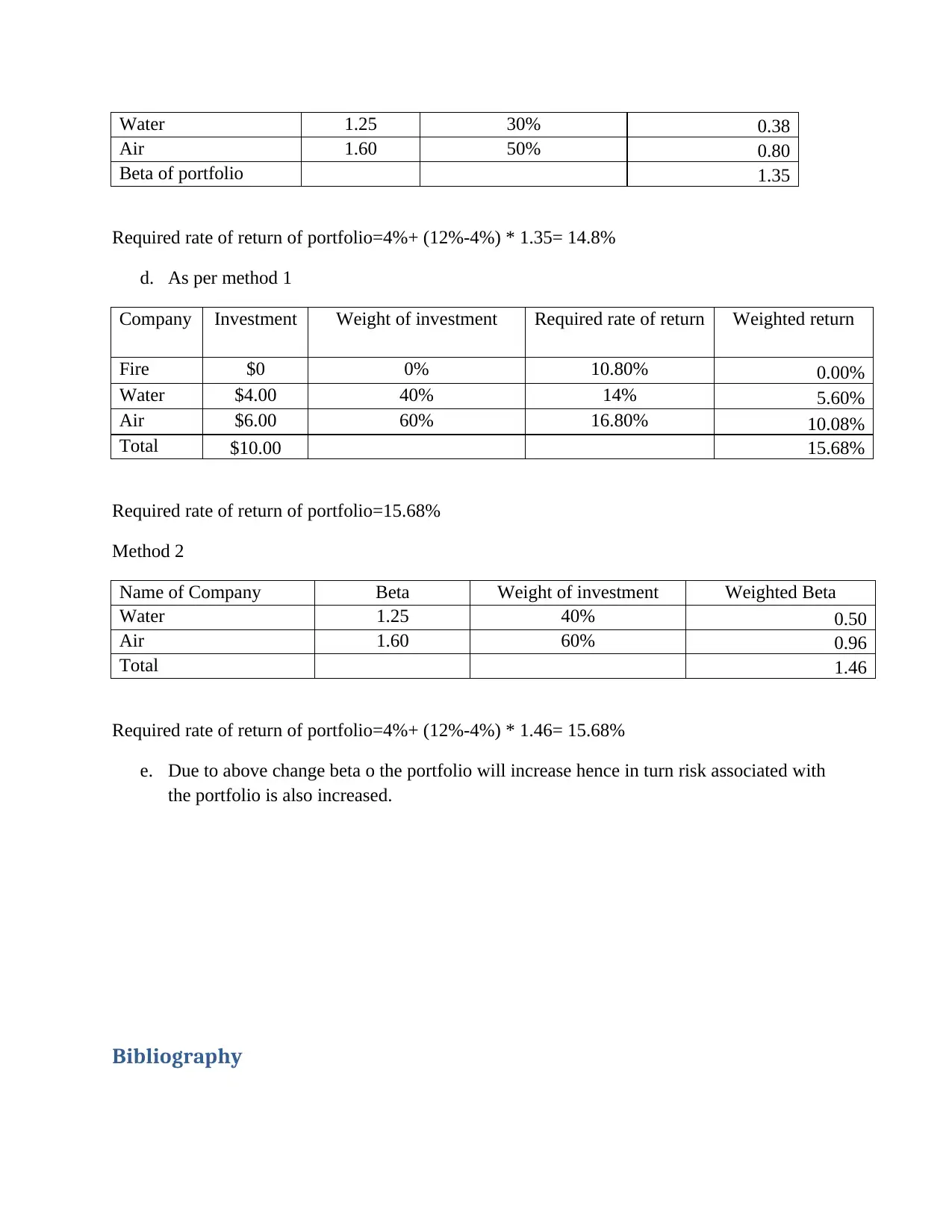
Water 1.25 30% 0.38
Air 1.60 50% 0.80
Beta of portfolio 1.35
Required rate of return of portfolio=4%+ (12%-4%) * 1.35= 14.8%
d. As per method 1
Company Investment Weight of investment Required rate of return Weighted return
Fire $0 0% 10.80% 0.00%
Water $4.00 40% 14% 5.60%
Air $6.00 60% 16.80% 10.08%
Total $10.00 15.68%
Required rate of return of portfolio=15.68%
Method 2
Name of Company Beta Weight of investment Weighted Beta
Water 1.25 40% 0.50
Air 1.60 60% 0.96
Total 1.46
Required rate of return of portfolio=4%+ (12%-4%) * 1.46= 15.68%
e. Due to above change beta o the portfolio will increase hence in turn risk associated with
the portfolio is also increased.
Bibliography
Air 1.60 50% 0.80
Beta of portfolio 1.35
Required rate of return of portfolio=4%+ (12%-4%) * 1.35= 14.8%
d. As per method 1
Company Investment Weight of investment Required rate of return Weighted return
Fire $0 0% 10.80% 0.00%
Water $4.00 40% 14% 5.60%
Air $6.00 60% 16.80% 10.08%
Total $10.00 15.68%
Required rate of return of portfolio=15.68%
Method 2
Name of Company Beta Weight of investment Weighted Beta
Water 1.25 40% 0.50
Air 1.60 60% 0.96
Total 1.46
Required rate of return of portfolio=4%+ (12%-4%) * 1.46= 15.68%
e. Due to above change beta o the portfolio will increase hence in turn risk associated with
the portfolio is also increased.
Bibliography
Paraphrase This Document
Need a fresh take? Get an instant paraphrase of this document with our AI Paraphraser
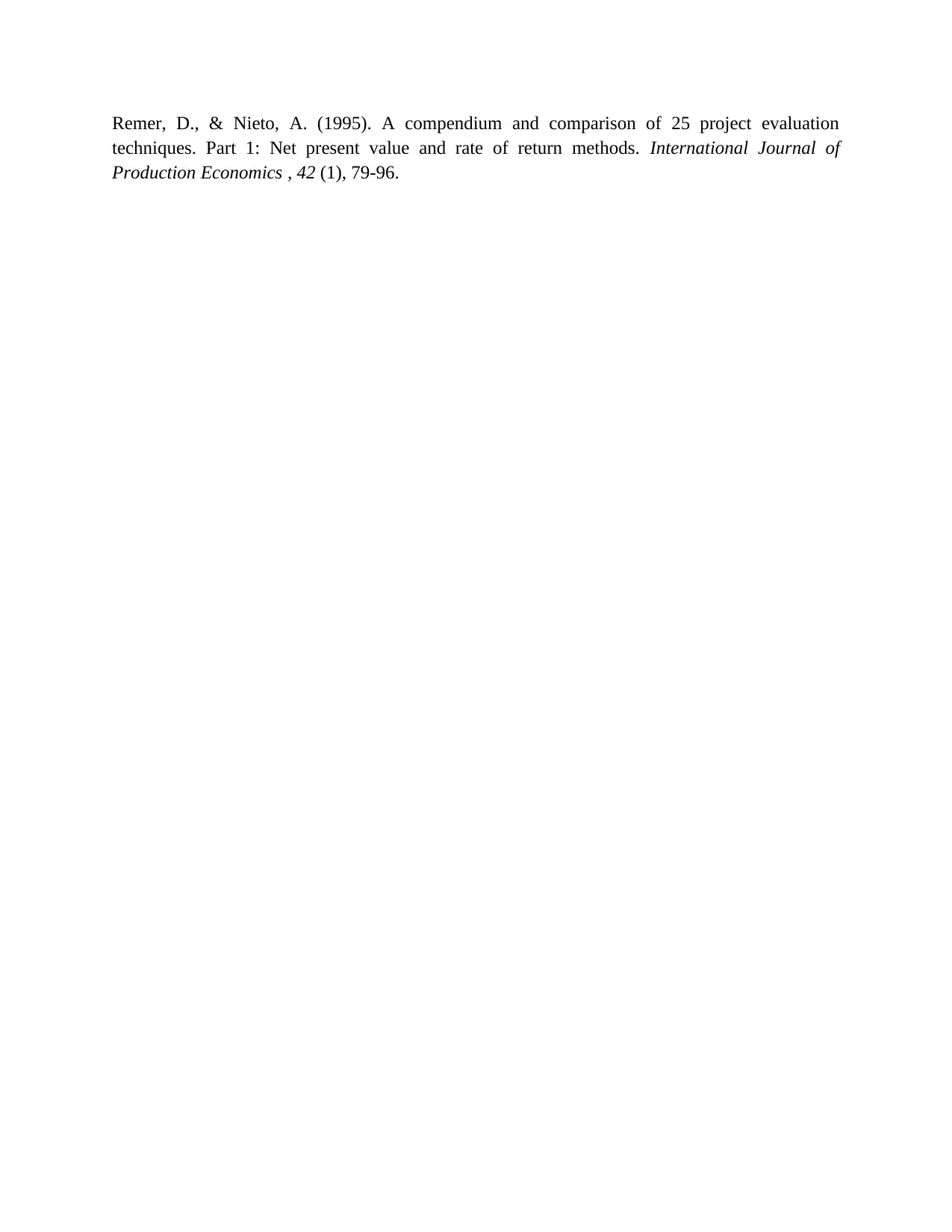
Remer, D., & Nieto, A. (1995). A compendium and comparison of 25 project evaluation
techniques. Part 1: Net present value and rate of return methods. International Journal of
Production Economics , 42 (1), 79-96.
techniques. Part 1: Net present value and rate of return methods. International Journal of
Production Economics , 42 (1), 79-96.
1 out of 11
Related Documents
Your All-in-One AI-Powered Toolkit for Academic Success.
+13062052269
info@desklib.com
Available 24*7 on WhatsApp / Email
![[object Object]](/_next/static/media/star-bottom.7253800d.svg)
Unlock your academic potential
Copyright © 2020–2025 A2Z Services. All Rights Reserved. Developed and managed by ZUCOL.
![Financial Problems Analysis: Finance Assignment for [University Name]](/_next/image/?url=https%3A%2F%2Fdesklib.com%2Fmedia%2Fimages%2Fsr%2F60e406c63e90418b8e9357fd9a9a4d51.jpg&w=256&q=75)


